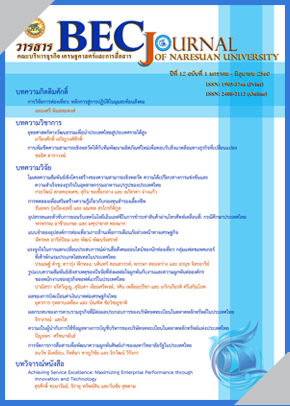การเพิ่มขีดความสามารถเชิงพลวัตให้กับทีมพัฒนาผลิตภัณฑ์ใหม่ เพื่อตอบรับสิ่งแวดล้อมทางธุรกิจที่เปลี่ยนแปลง
Main Article Content
บทคัดย่อ
ทีมพัฒนาผลิตภัณฑ์ใหม่หรืออาจเรียกว่าเป็นทีมงานข้ามฝ่ายจะประกอบด้วยสมาชิกที่มีทักษะ และความชำนาญที่แตกต่างกันและส่งเสริมซึ่งกันและกันเพื่อให้โครงการผลิตภัณฑ์ใหม่ประสบความสำเร็จ โดยสมาชิกทุกคนจะทำงานร่วมกันในแต่ละขั้นตอนของกระบวนการพัฒนาผลิตภัณฑ์ เริ่มจากการค้นหาความต้องการของตลาดไปจนถึงการแนะนำสินค้าและบริการในกลุ่มตลาดเป้าหมาย ทีมประเภทนี้มีความสำคัญอย่างมากต่อองค์กรในการสร้างสรรค์สินค้าและบริการใหม่เพื่อสร้างข้อได้เปรียบทางการแข่งขันให้กับธุรกิจ การเพิ่มขีดความสามารถเชิงพลวัตให้กับสมาชิกทุกคนจะทำให้ทีมพัฒนาผลิตภัณฑ์สามารถปรับตัวให้เข้ากับสถานการณ์ทั้งภายในและภายนอกองค์กรที่เปลี่ยนแปลงอยู่ตลอดเวลา
วัตถุประสงค์ของบทความนี้คือ เพื่อทบทวนวรรณกรรมที่เกี่ยวข้องกับองค์ประกอบของความสามารถเชิงพลวัตและแนะนำการเพิ่มระดับความสามารถนี้ให้กับสมาชิกในทีมพัฒนาผลิตภัณฑ์ในการใช้ทรัพยากรจากภายนอกได้อย่างมีประสิทธิผลสูงสุด นอกจากนี้ เนื้อหาของบทความยังรวมถึงผลประโยชน์ของการเพิ่มระดับความสามารถดังกล่าวที่มีต่อศักยภาพของทีมพัฒนาผลิตภัณฑ์ โครงการผลิตภัณฑ์ใหม่ และกระบวนการพัฒนาผลิตภัณฑ์
Article Details
เอกสารอ้างอิง
2. Atuahene-Gima, K. and Li, H. (2004). Strategic decision comprehensiveness and new product development outcomes in new technology ventures. Academy of Management Journal, 47(4), 583-597.
3. Cobb, C. L., Agogino, A. M., Beckman, S. L. and Speer, L. (2008). Enabling and characterizing twenty-first century skills in new product development teams. International Journal of Engineering Education, 24(2), 420-433.
4. Cohen, W. M. and Levinthal, D. A. (1990). Absorptive capacity: A new perspective on learning and innovation. Administrative Science Quarterly, 35(1), 128-152.
5. Crowston, K. and Kammerer, E. E. (1998). Coordination and collective mind in software requirements development. IBM System Journal, 37(2), 227-245.
6. Darawong, C. (2015). Enhancing absorptive capacity of new product development teams for Thai SMEs. Journal of Business, Economics and Communications, 10(1), 4-41.
7. Darawong, C, Ruangrob, A. and Apirattanapimolchai, A. (2014). Cross-functional communication and new product development outcomes. Sripatum Chonburi Journal, 11(2), 1-8.
8. Eisenhardt, K. M. and Galunic, D. C. (2000). Coevolving: At last, a way to make synergies work. Harvard Business Review, 78(1), 91-101.
9. Flatten, T. C., Engelen, A., Zahra, S. A. and Brettel, M. (2011). A measure of absorptive capacity: Scale development and validation. European Management Journal, 29(2), 98-116.
10. Galunic, D. C. and Rodan, S. (1998). Resource recombinations in the firm: Knowledge structures and the potential for schumpeterian innovation. Strategic Management Journal, 19(12), 1193-1201.
11. Helfat, C. E. and Peteraf, M. A. (2003). The dynamic resource-based view: Capability lifecycles. Strategic Management Journal, 24(10), 997-1010.
12. Hurley, R. F. and Hult, T. M. (1998). Innovation, market orientation, and organizational learning: An integration and empirical examination. Journal of Marketing, 62(3), 42-54.
13. Nicholas, J., Ledwith, A. and Perks, H. (2011). New product development best practice in sme and large organisations: Theory vs practice. European Journal of Innovation Management Science, 14(2), 227-251.
14. Office of the national economic and social development board. (2014). Outlook of the improvement of research and development in Thailand. Journal of economics and society, 51(1), 27-32.
15. Okhuysen, G. A. and Eisenhardt, K. M. (2002). Integrating knowledge in groups: How formal interventions enable flexibiliy. Organization Science, 13(4), 370 - 386.
16. Park, K. and Kim, B. K. (2013). Dynamic capabilities and new product development performance: Korean SMEs. Asian Journal of Technology Innovation, 21(2), 202-219.
17. Pavlou, P. A. and Sawy, O. A. E. (2011). Understanding the elusive black box of dynamic capabilities. Decision Sciences, 42(1), 239-273.
18. Pfeffer, J. and Salancik, G. R. (2003). The external control of organizations: A resource dependence perspective. CA: Standford University Press.
19. Pimsawadi, L. (2008). Dynamic capabilities and distinctive competencies: A basic concept of strategic plan leading the organization to sustainable competition in the era of knowledge society. Executive Journal, 28(3), 34-38.
20. Rothaermel, F. T. and Hess, A. M. (2007). Building dynamic capabilities: Innovation driven by individual-, firm-, network-level effects. Organization Science, 18(6), 898-921.
21. Sinkula, J. M. (1994). Market information processing and organizational learning. Journal of Marketing, 58(1), 35-45.
22. Teece, D. J. (2007). Explicating dynamic capabilities: The nature and microfoundations of (sustainable) enterprise performance. Strategic Management Journal, 28(13), 1319-1350.
23. Teece, D. J., Pisano, G. and Shuen, A. (1997). Dynamic capabilities and strategic management. Strategic Management Journal, 18(7), 509-533.
24. Unger, D. and Eppinger, S. (2010). Improving product development process design: A method for managing information flows, risks, and iterations. Journal of Engineering Design, 22(10), 1-11.
25. Verona, G. (1999). A resource-based view of product development. Academy of Management Review, 24(1), 132-142.
26. Zahra, S. A. and George, G. (2002). Absorptive capacity: A review, reconceptualization, and extension. Academy of Management Review, 27(2), 185-203.
27. Zander, U. and Kogut, B. (1995). Knowledge and the speed of the transfer and imitation of organizational capabilities: An empirical test. Organization Science, 6(1), 76-92.
28. Zollo, M. and Winter, S. G. (2002). Deliberate learning and the evolution of dynamic capabilities. Organizational Science, 13(2), 339-351.


